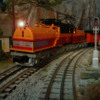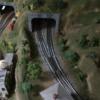I hate to be a dissenter, but out of the 12 RCS curved switch tracks I have (together with 46 Atlas switch tracks), I have derailing issues with about half of them (RCS) when backing up several of my steam engines (problems with the tenders), and even in forward motion with other steam engines (Legacy 4-8-4 locomotive itself, for example). No derailing issues with any of the Atlas.
Upon closer examination, I believe that the RCS assembly crew who put together my switch tracks were not the regular workers. I compared the ones I have with one that Alan Arnold gave me just for this purpose, and there was a noticeable difference. Mine had many of the spikes bent the wrong way and protruding, the rails had kinks, of which I was able to fix a few and posted that procedure here, towards the end of the thread, but the problems still persist on others. BTW, I bought all of mine from Bob Thatcher in 2010.
Alex








